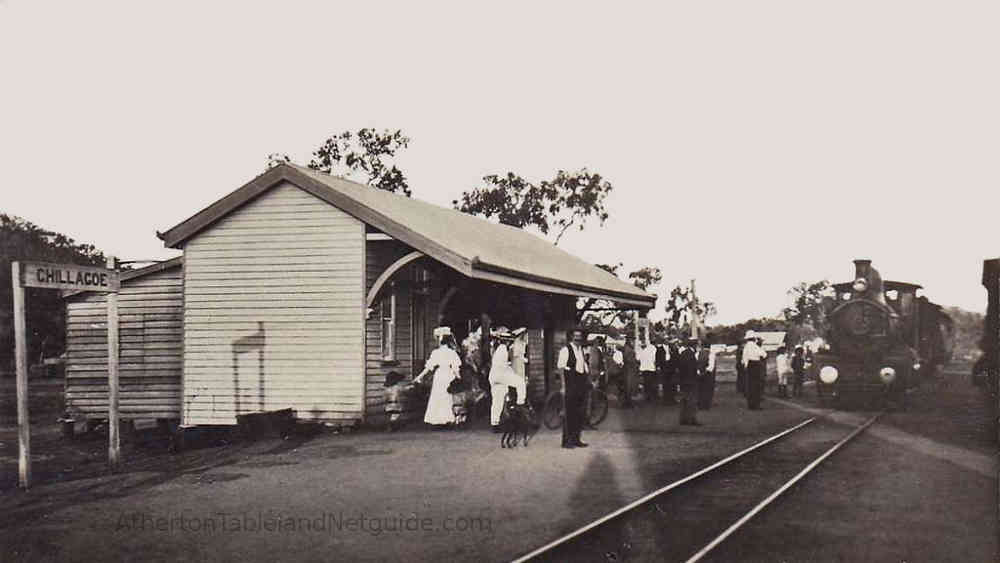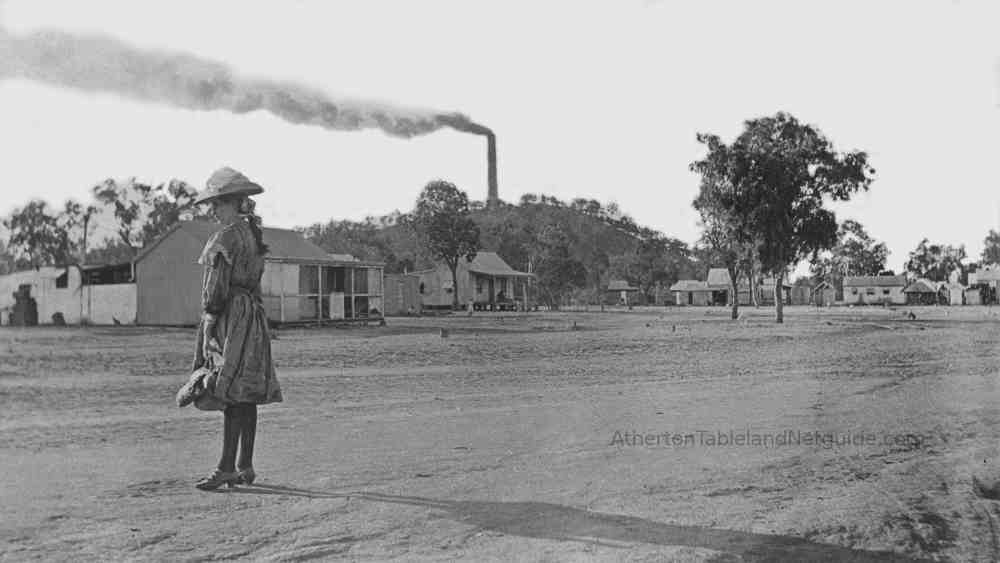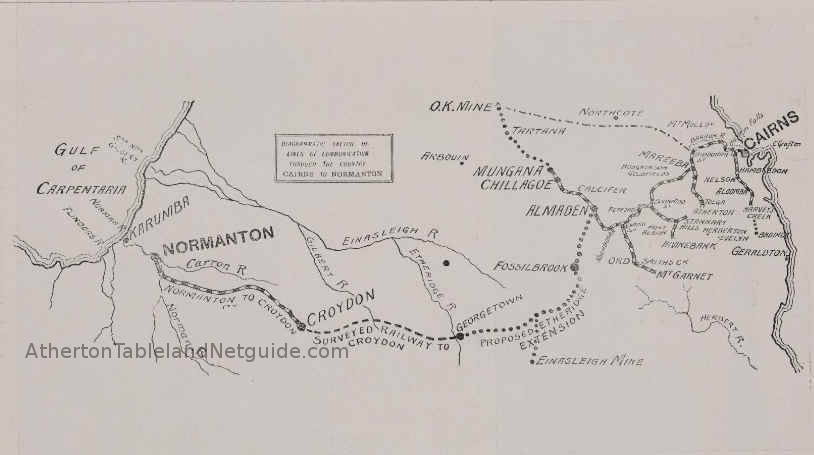

Chillagoe is a word from an old sea shanty: "ikey, cryke, psyke, mikey, chillagoe wallabodorie" and was the name given to William Atherton's Cattle station in 1888.
In 1888 low tin prices and the collapse of the Montalbion silver-lead enterprises motivated John Moffat to send a prospecting party into the chillagoe area to assess reports made during Mulligan's 1873 expedition and backed up by William Atherton of rich copper deposits among the limestone outcrops.
There was a promise here of a quick return on investment in easily accessible and richly assaying lodes. Still reeling from the collapse of Montalbion and low tin prices at Irvinebank, Moffat planned to assay prospects around Chillagoe and to develop them with outside capital.
Fantastic samples were gained from the surreal landscape of Chillagoe, including a solid piece of ruby copper ore mixed with metal weighing 1368 kg (3024lbs). Pieces like this were displayed in Moffat and Company's exhibit at the Melbourne Centennial Exhibition in 1888.

Moffat swiftly monopolised the field, applying for claims and naming them after Gilbert and Sullivan opera titles, people from his circle of family and friends and loyal employees. They included the Cyclone, Tea-Tree, McTavish, Silver North, Fortunata, Martha, Pinafore, Midas, Belphagor, Desdemona, Dorothy, Penzance, Ruddygore, and many more.
Out of 34 of the original leases pegged around Chillagoe, Moffat's company held 26.

Moffat visited the field and chose the site of a smelter on Stockman's Creek. His party camped on the banks and formed the outpost that became the township of Zillmanton, recieving provisions by dray from Irvinebank. In four months Moffat had invested £3,000 on the Chillagoe field.
It was around this time that Moffat wrote to George Waddell, "the north is a very fine place for making money but a very poor one for keeping it".
By November 1891 Moffat had spent £20 000 on the Chillagoe field for almost no return. The challenge was maintaining a minimum level of employment in order to satisfy the labour conditions of the mining leases at a time when base metals prices were low. Transport and other costs were high due to the remoteness of the field and lack of road or rail infrastructure.
In 1892 Moffat commissioned a survey for a Cairns to Chillagoe Railway, with which he hoped would secure government investment. However, the early 1890s were depression years with low commodity prices and bank and share market crashes. Moffat soon realised that there was little chance of state funding or private investment in these economic circumstances.
The Chillagoe field languished for a few years with Moffat's enterprises furnishing a hodge podge of machinery recycled from failed prospects in other areas. The prospectors, miners and workers holding the field were poorly paid and lived in harsh and primitive conditions.
As hopes faded in 1893 for government investment in infrastructure, Moffat bought a second hand smelter from a defunct company at Newellton and had it relocated to Calcifer in order to create faith in the field's potential to southern investors. In 1896 he built a second smelter on the field at Girofla.
In 1897, Moffat fueled his dream of an industrial centre in the north of the Continent, close to the Torres Strait and northern sea routes. On a trip to Melbourne he secured the interest of the millionares of the Broken Hill enterprises who saw an opportunity to float the 'next Broken Hill' - a new boom in mineral and sharemarket wealth.
Through the vehicle of the Chillagoe Proprietary Company, Moffat and partners created a syndicate which intended to invest £300,000 in mines, smelters and a private railway from Mareeba. Moffat presented the plan to the Queensland government, who quickly passed a favourable act of parliament, guaranteeing, among other things, government purchase of the railway after 50 years. The Chillagoe Proprietary Company was then restructured into the Chillagoe Railway and Mines Limited.
The railway reached Lappa in October 1900. On 31 December a special train carrying guests travelled to a point within 3 miles of Chillagoe and the mining warden declared the line to be one of the most attractive tourist lines in Queensland. The railway was officially opened to Chillagoe and Mungana 4 March 1901.

Before the railway reached Chillagoe the boom was on. Town allotments were sold by auction and speculators touted the name 'Chillagoe' on the sharemarket. Two problems beset Chillagoe - the prospected ore deposits did not live up to expectations and development costs were high. John Moffat was caught between his desire to develop a sustainable industrial economic community, and a massive speculative boom based on overestimation of ore bodies and the desire of southern capitalists to make huge capital gains fast.
The first Chillagoe Railways and Smelters company folded in 1901 after expending too much capital and borrowing heavily. Operating costs for the smelter were high. Canadian coal was used at great expense in absence of the local product, and a downgrading of reserve estimates caused a share market plunge. The directorship and management of the project had been dominated by southern directors, unfamiliar with the region, its geography and characteristic mineral deposits. Many of the policies causing the downfall were made against the advice of John Moffat, at that time the most experienced developer in the region.

Moffat felt that his good name and reputation had been used to fuel the boom and he was the only director to have maintained and increased his shares by November 1901, when the Chillagoe Smelter both opened and closed. His main motivation for the Chillagoe enterprise had been to raise venture capital for a central Tableland smelter and industrial center.
Moffat was prepared to invest heavily to develop mines and provide employment. He had long term vision for stable, viable communities and was prepared to foster local economies rather than encouraging destabilising booms and busts. The Chillagoe bubble had burst, but valuable infrastructure in smelters and railways had been developed. It served Moffat's enterprises from Mareeba to Chillagoe and beyond and also provided the possibility of a long term future for the nascent community of Chillagoe.

A new company was formed in 1902 to take over the project and production continued to 1914.

In 1919 the Queensland Government, in a policy devised by Edward Granville (Red Ted) Theodore bought the assets of the Chillagoe Railway and Smelter Company and ran the operation as the Chillagoe State Smelters until the operation finally closed in 1943.